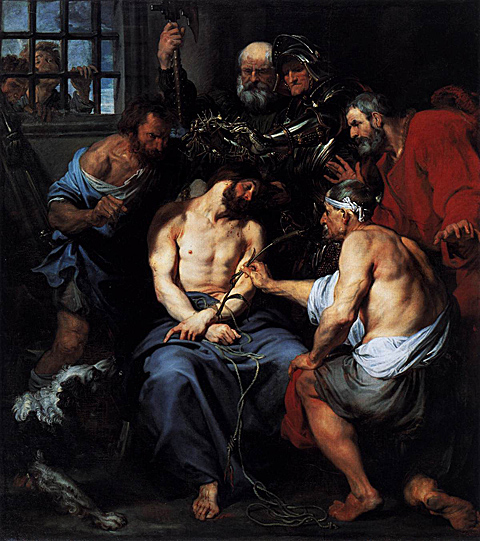When I went to the art stacks underneath Lilly, I had expected a simple shelf of books arranged by time period or artistic movement, never the huge, detailed collection that I actually found. I’ll definitely be going down there more often to peruse books! The vast collection made it more difficult to choose an artist to write about, but I ultimately decided on Anthony van Dyck.
Anthony van Dyck (1599-1641) was a Baroque artist from Antwerp, Belgium. He was a student of Peter Paul Rubens and is famous for his portraits (especially of King Charles I of England) and prints. He also created many religious paintings. Van Dyck's interest in art was obvious from a young age. When he was a student f Rubens, van Dyck was encouraged to cultivate his skill in portraiture. When he traveled to Venice, he studied and made sketches of the works of Titian, an artist he greatly admired. After travelling to various places, including Rome, Sicily, and Genoa, van Dyck went to England in 1632 to work as a court painter for King Charles I. Van Dyck was very influential on the artists in England and sought after by many. With commissions came money, and van Dyck became gluttonous and took mistresses. A marriage was arrange for him in the hopes that he would settle down, and he returned to Antwerp with his wife. When he tried to return to England, the royal family was separated, and he did not receive the same hospitality as before. Suffering from depression and sickness, van Dyck later died at age 42.
What struck me the most about van Dyck was the incredible amount of preparation that went into each of his paintings. I found a book of drawings by the artist and was surprised by how much detail he put into sketches that were used as preparation for a painting. In fact, van Dyck is known for creating sketches in which he would greatly change the composition to determine what would work best. Every painting necessitated several study drawings of individual aspects, such as the position of a person’s back or a horse’s leg. It is really interesting to see how the painting “evolves” from the original rough sketch to the more detailed sketch that is transferred onto the canvas to the finished painting itself.
For example, van Dyck’s The Crowning with Thorns began with some study drawings. The one shown below depicts Christ, the main character of the piece. There is minimal shading or detail (the hand holding onto his hair is only roughly drawn in). What van Dyck focused on was the positioning of the body and face. I think the anguish on the face is very well done.
Study for The Crowning with Thorns, Black chalk.
The next sketch depicts the whole composition. Van Dyck made many of such paintings, often using pen, brown ink, and a brown wash. This sketch is even more rough, with the focus being much more on composition. The figures are placed on the lower right hand corner. The brown wash is used to indicate shadow and perhaps more details that will later appear in the painting.
c. 1618-1621
The Crowning with Thorns. Pen and brown ink, with brown wash, 239 x 208 mm.
I included the finished painting to show how much effort went into perfecting the composition of the piece. The figures now take the main body of the piece, and Christ’s body is less angled.
c. 1618-1620
Crowning with Thorns
Oil on Canvas. 223 x 196 cm
Museo del Prado, Madrid
Van Dyck’s Iconography is a series of prints of portraits of famous people of the time. To create these prints, he first made a drawing of the figure, and then the figure was etched (either by himself or an engraver). Van Dyck is famous for his portraits, especially his ability to infuse his subjects with elegance and character. I think his drawing style is very soft and intimate. His unique, direct etching style was also emulated by many engravers.
This drawing of a man named Erycius Puteanus is characteristic of van Dyck's portraiture style. The smaller image is the actual print that was created from the drawing, and one can see that the lines are darker (because it was made from an etching), and the image is mirrored.
Erycius Puteanus
Black chalk, with brown wash, 242 x 173 mm.
Erycius Puteanus. Print.
References
"Anthony Van Dyck." Artble: The Home of Passionate Art Lovers. Web. 07 Oct. 2011.Brown, Christopher, and Dyck Anthony Van. Van Dyck Drawings. New York: Harry N. Abrams, 1991. Print.
http://www.wga.hu/frames-e.html?/html/d/deck/3other/crowning.html





No comments:
Post a Comment